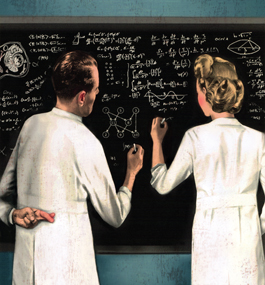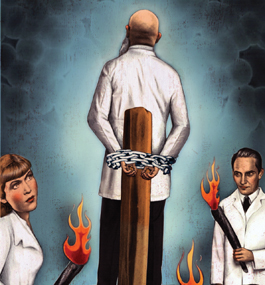An Epistemology of Scientific Crackpottery
How do you distinguish the contrarian heroes of science, destined to make big advances in their field, from the charlatans of science, madly in love with their own ideas?

Craig LaRotonda
by Laura Gardner, P’12
A decade ago, Woo-Suk Hwang was a pioneering researcher at Korea’s Seoul National University, a puzzle solver who cracked one of the most dazzling challenges in modern biology: human somatic cell cloning.
Hwang’s breakthrough came in 2004, when he published the first of two papers in the respected journal Science. The veterinarian turned biotech trailblazer announced his lab had created the first human embryonic stem cell through the cloning of donor eggs, by removing the nucleus from a somatic (body) cell and implanting it into an enucleated egg cell. Dolly the sheep had been cloned using this technique in 1996.
In 2005, Science published an even more arresting article. Hwang claimed his lab had created 11 stem cell lines from cloned human embryos, paving the way for therapeutic stem cells genetically matched to patients — a seismic scientific advance.
Hwang became a national hero, the “Pride of Korea.” A postage stamp was issued in his honor, and Korean Air gave him a decade of free first-class seats. He also achieved the kind of international celebrity rarely bestowed on white-coat researchers from any country.
But just months later, in early 2006, Hwang’s cell lines were discovered to be bogus, his data fabricated. Science quickly retracted both papers, and Hwang was disgraced, unmasked as a con artist who faked data in the pursuit of personal glory.
Though perhaps more ambitious than most, Hwang’s deception is typical of scientific cons, says Chris Miller, professor of biochemistry and longtime Howard Hughes Medical Institute Investigator.
And, like all con men, Hwang was ultimately exposed by the “inherently self-correcting nature of scientific inquiry,” Miller says. In other words, people figured out his results were just too good to be true — and checked them.
Miller spends most of his time studying the structure and function of ion channels, membrane proteins involved in electrical signaling. However, a secondary interest was born when, as a doctoral student, he worked in the lab of an accomplished scientist he ultimately realized was a classic crackpot. Since then, Miller has developed what he calls an “epistemology of scientific crackpottery.”
An epistemology, he explains, “is a system of knowing how we know what we think we know.” He says his is designed to “distinguish the brilliant, creative, contrarian heroes of science, who move their fields forward, from the crackpots, who are also brilliant, creative contrarians.”
Miller’s epistemology proposes four scientific-outlier phenotypes: con men (and they do seem to be all men), like Hwang; mountebanks, more akin to snake-oil salesmen than working scientists; and two types of scientific heretics — heroes and crackpots.
Heretic-heroes interest Miller the most. Two examples are Oswald Avery, who discovered that genetic material comes from DNA, and Nobel Prize winner Barbara McClintock, who discovered genetic transposition. “Heretics get burned at the stake,” Miller says. “But they turn out to be right.” Heretic-crackpots, on the other hand, stay religiously attached to their ideas, even in the face of mounting contrary evidence.
The University of Pennsylvania lab where Miller worked as a doctoral student was headed by Gilbert Ling, a brilliant contrarian who was sure that cell membranes didn’t exist.
“Ling had alternative ideas for all the functions we attribute to cell membranes,” says Miller. “His ideas appealed to me at the time because I was trained as a physicist and didn’t know any biology at all.”

Craig LaRotonda
page 2 of 3
But as he worked his way through Ling’s theory, given the known facts of cell physiology, Miller came to reject his adviser’s ideas completely. The resulting scientific rift was irreparable. Ling didn’t even show up at Miller’s dissertation defense, prompting, Miller says, “a last-minute slapstick scene, in which my depleted thesis defense committee frantically commandeered a hapless passerby to just sit there and make up a quorum so they could get rid of me, PhD in hand.”
Ling, now in his 90s, is still “ranting” that fellow scientists know he’s right but are too invested in their own science to see the truth, says Miller. “That’s where you really see the paranoia. Ling has made no progress. He hasn’t moved his field forward.
“All crackpots,” Miller continues, “end up being pathetic.”
Earlier this year, Miller, a member of the National Academy of Sciences, presented his crackpottery epistemology to a full house in one of academe’s most august settings: the University of Oxford’s Museum of Natural History, in the very room where, in 1860, T.H. Huxley and Bishop Samuel Wilberforce went head to head on Charles Darwin’s theory of evolution.
The public lecture was the capstone of Miller’s sabbatical stint as Oxford’s Newton Abraham Visiting Professor in the Medical, Biological and Chemical Sciences. When he returned to his home turf, Miller ruminated about scientific crackpots with Brandeis Magazine.
Let’s talk about the mountebanks and the con men first. What are the mountebanks’ distinguishing features?
They are hot-air artists, modern versions of the old-time carnival barkers, who promised that inside the tent you’d see an amazing four-legged boy.
My favorite is Deepak Chopra, a doctor who fancies himself a quantum physicist, and who attracts huge, gullible, fee-paying audiences expecting to be made well through his idiotic program of “quantum healing.” It’s the modern version of the Lourdes grotto.
Money is always involved — lots of it, flowing either from a gullible public or from large bureaucracy-heavy grants programs. But mountebanks are not purveyors of scientific fraud. They merely deal in promises of the wonders to come.
What about con men?
Like Woo-Suk Hwang, they pop up in spectacular data-fabrication scandals, which working scientists view with a mixture of righteous outrage and schadenfreude.
These fraudsters are often young scientists widely perceived to be rising stars, driving important breakthroughs in high-profile fields, working in the labs of eminent senior colleagues.
Unlike the mountebank, the con man focuses like a laser on a specific, substantive and timely scientific problem his research promises to advance. The mountebank can keep going for a long time on promises and hope. The con man’s fireworks are always short-lived, thanks to the self-corrections of scientific inquiry.
Who else has transgressed like Hwang did?
There are many examples of pure fraud. In 1974, William Summerlin, a rising-star immunologist at Memorial Sloan Kettering Cancer Center, generated great excitement by overcoming tissue rejection in skin transplants between black and white mice. Animal-care technicians discovered he had colored the white mice with black markers after the “transplant” washed off with alcohol wipes.
What do we do about mountebanks and con men?
Mountebanks are very easy to detect. I’m convinced they know they’re fooling their audience.
Con men should be banned from receiving National Institutes of Health grants, thereby subjected to the scientific equivalent of the death penalty. But I don’t think they do much harm. Their frauds are always found out very quickly.
page 3 of 3
How do heretic-heroes fit into your theory of crackpottery?
Heretic-heroes are deeply creative, substantive scientists whose contrarian ideas are initially dismissed, rejected and ridiculed by their colleagues. In a few cases, their ideas are utterly ignored.
Heroes are stubborn. They are passionate. They can be egotistical and ambitious. But they are also open-minded, willing to digest the evidence that nature provides. They might be laughed off the stage when they propose their ideas, but these ideas are eventually incorporated into the mainstream, because they expand the edge of discovery.
Who comes to mind?
Barbara McClintock, a plant geneticist who worked on chromosomal crossing over. In 1950, she published her radical findings on transposition, or jumping genes. She met with so much hostility she stopped publishing on transposition in 1953 — but kept working on it.
It wasn’t until the mid-1960s, after her retirement, that her work earned recognition. Eventually, she won the usual string of awards leading to the Nobel. Her first recognition by the scientific community was Brandeis’ Rosenstiel Award in 1977, followed in 1981 by the first MacArthur Foundation Grant ever given.
Australian physicians Barry Marshall and Robin Warren are another good example of heretic-heroes. They overturned the universally held view that peptic ulcers are caused by anxiety or excess acid, showing that ulcers and certain stomach cancers are caused by the bacterium Helicobacter pylori. To test his conviction, Marshall drank a culture of H. pylori excavated from a patient’s stomach juice. He experienced severe gastritis within a week, then cured himself with antibiotics.
What clues give the scientific crackpot away?
No features infallibly identify a crackpot. But certain indicators do raise our suspicions. Crackpots frequently see themselves as revolutionaries, and create extended narratives about their own contrarian position in a controversy.
For example, many of Ling’s books include “revolution” in their title. Berkeley virologist and AIDS denier Peter Duesberg — he claims HIV is a harmless passenger virus — has referred to himself as a “courageous independent scientist resisting orthodoxy,” modestly invoking Galileo as an example.
This sort of revolutionary flag-waving is absent among the heroes, who focus on specific scientific problems, not their personal position in a controversy.
Also, an odor of Napoleonic, delusionary certainty often infects crackpot narratives and is never seen in hero narratives.
Consider Linus Pauling, arguably the greatest 20th-century chemist. He was convinced vitamin C could prevent the common cold, despite many double-blind trials finding no effect. He continued pushing vitamin C as a cure for cancer, heart disease and AIDS, claiming that “75 percent of all cancer can be prevented and cured by vitamin C alone.”
At the end of the day, this determined lack of open-mindedness is the clearest sign of crackpottery.
Ironically, it seems Ling set you on a course to becoming a successful scientist.
Ling had more influence on me than any other scientist I have known. But he is a tragic figure — his wealth of personal and professional virtues were nullified by his rigid attachment to a theory. He violated the first commandment of science: When nature speaks, listen.
He instilled in me a bizarre love for small inorganic ions. But his greatest influence on me, I reckon, was to instill a profound aversion to becoming emotionally attached to one’s own ideas.
Science seems to require a strong stomach for ambiguity.
The pervasive ambiguity of biological science is one of its greatest delights. When a scientist navigates through muck and suddenly cracks a problem, there is the sublime excitement of discovery. My own research into membrane biophysics has given me a career’s worth of happy ambiguity, in both observation and interpretation.
But ambiguity also creates the soft spots where mountebanks, con men and crackpots are free to ply their trade.
